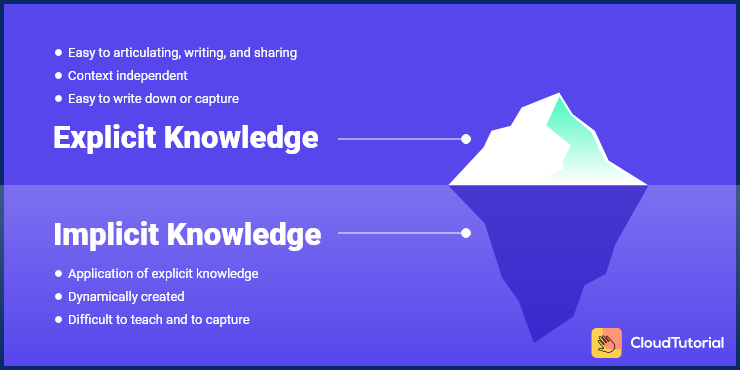It is rightly said that the more business knowledge your team members possess about your consumers’ products and services, the more successful your organization will be.
At times, the knowledge seized by your team members is a lot more challenging to document or communicate. Such knowledge acquired by a team of your employees through their experience is usually tough to communicate and is mainly referred to as ‘tacit or implicit knowledge’.
In this blog, we will understand more about this kind of knowledge and the benefits your organization can gain.
Table of Content
What is Implicit Knowledge?
Implicit knowledge or ‘tacit knowledge’ is the type of knowledge that is complex to transmit to another individual using verbalizing or writing it down. It can be well-defined as experiences, culture, ideas, and skills that the public has but are not classified and may not essentially be simply articulated.
With tacit knowledge, a team member is not mostly conscious of the knowledge she or he has or how it can be of benefit to others.
Active transfer of tacit knowledge usually needs enormous regular interaction, trust, and personal contact. This form of knowledge management can only be publicized through best practices in a specific framework and transferred through social networks. To some level, it is ‘captured’ when the knowledge holder connects to a community or a network of practice in the organizations.
Such tacit knowledge is attained through incidental events, or without consciousness that learning is happening. Some patterns of everyday job and tacit knowledge are playing the piano, riding a bike, driving a car, thumping a nail with the hammer, understanding an intricate statistical equation, and the ability to place together parts of a composite jigsaw puzzle.
The term tacit knowledge or tacit knowing is accredited by Michael Polanyi in Personal Knowledge in 1958. In his future work ‘The Tacit Dimension’, he stated, “We can know more than we can tell.” He asserts that knowledge cannot be sufficiently expressed by any verbal means and is deep-rooted in tacit knowledge.
Examples of Implicit Knowledge
Occasionally, tacit knowledge is identified by a few other terms like tribal knowledge, experiential knowledge, and ‘know-how’ knowledge. Here, the ability of ‘know-how’ denotes the notion that, at times, a team of employees just cannot elucidate how they know what they understand or identify ways to do.
In this version, ‘Know-how’ or embodied knowledge is a trait of the expert, who performs and makes decisions, without plainly reflecting on the rules or principles involved. This expert functions without having a model of her or his work.
One just acts skilfully without planning or dedicated attention. Such kind of knowledge signifies a learned skill of the human body’s endocrine and nervous systems.
The below-mentioned instances will help you understand it more clearly:
-
Language
One of the most considerable instances of tacit knowledge is the idea of language – it is not probable to learn any language just by knowing the grammar rules – a native person can speak her or his language at a young age, almost being completely unaware of correct grammar which she or he may be educated with at a later age.
-
Bessemer Steel Process
Another example is the Bessemer steel process. Bessemer traded a patent for his progressive steel making processes and was prosecuted by the buyers who could not get it to work.
In the final stage of the case, Bessemer established his steel company because he developed skills of how to do it, even though he could not express it to his patent consumers. His company turned out to be one of the largest steel-making companies in the world and changed the way the industry looked.
-
Facial Recognition
One more example is the ‘facial recognition’. We know an individual’s face and can identify it amongst a million faces. However, we typically cannot say how we distinguish a face we know, and hence, this cannot be put into words.
When you look at a face, you are not cognizant about the features of someone, that is, nose, eyes, mouth, but you see something and distinguish the face as a whole.
-
Other Instances
Some more instances are how tight a bandage should be, how to ride a bike, understanding whether an experienced surgeon feels an intern is prepared to acquire the complexities of surgery or not. All this can be attained by personal experience or experimentation only.
Build an advanced knowledge base for your customers and give them answers fast – real fast.
Take your app and help center to the next level with CloudTutorial.
Opposite of Implicit Knowledge
Tacit knowledge can be differentiated from explicit knowledge in three chief areas:
-
Key Approaches For The Accumulation And Acquisition
Explicit knowledge can be created through skills like rational deduction and attained by practical experience in the pertinent ways. On the contrary, tacit knowledge can only be learned by having a personal experience in the relatable content by the teams.
-
Potential of Accumulation And Means of Appropriation
Explicit knowledge can be gathered at a particular location, deposited in value systems, and seized without the contribution of knowing the subject. In contrast, tacit knowledge is contextual and personal. It is dispersed across the knowing subjects and the source cannot be aggregated easily.
The comprehension of its complete potential necessitates the close association and assistance of the knowing subject.
-
The Mechanism of Transmitting Knowledge
The explicit type of knowledge management is a process that can be codified. This means you can put it into words or write it down or draw a picture and can be easily conveyed without knowing the subject.
Whereas, tacit knowledge is an unarticulated and intuitive kind of knowledge that cannot be understood, or communicated, understood or utilized without knowing the subject.
Dissimilar to transmitting explicit knowledge, the transferral of tacit knowledge needs close contact and the build-up of the shared understanding and faith.
The process of converting tacit knowledge into specifiable or explicit knowledge is termed as articulation, codification, or specification. The tacit features of knowledge cannot be codified, but can only be transferred through personal experience or training skills.
Implicit vs Explicit Knowledge
To comprehend and form a knowledge management system, you first require to understand the diverse definitions and concepts of knowledge types – explicit and implicit knowledge.
The difference between implicit and explicit knowledge is conceivably the most essential concept of Knowledge Management. Tacit knowledge (knowing-how) means the knowledge rooted in the human mind through job and experience.
Personal wisdom, content-specific tasks, and experience are harder to excerpt and codify. This also includes awareness, insights, and intuitions.
While explicit knowledge (knowing-that) means the knowledge that can be codified and digitized in documents, books, memos, and reports. Such documented data can facilitate the actions required in the teams. This type of knowledge can be recognized, expressed, shared, and employed easily.
The following table on Implicit vs Explicit Knowledge will give a clear understanding of the dissimilarities between these two types of knowledge:
| Aspects | Explicit Knowledge | Implicit Knowledge |
|---|---|---|
| Definition | Explicit knowledge is already codified. | Implicit knowledge is embedded in the mind. |
| Content or Context | It has a fixed content. | It is context-sensitive or specific. |
| Basis | It has a rational, objective, and technical base. | It has a cognitive, subjective, and experiential learning base. |
| Creation | It is independent of context. | It is dynamically created. |
| Form | It has a structured form. | It is derived from personal experience. |
| Documentation | The information can be documented easily. | The information is difficult to capture or document, and hence, cannot be codified. |
| Knowledge Sharing or Conveying | As it can be documented, knowledge sharing becomes easy. | It is hard to convey but has a high value. |
| Basis | It has an externalized approach. | It has an internalized approach. |
| Knowledge Transfer | It can be taught, transferred, and learned easily. | It is tough to teach, transfer, and learn. |
| Intuition | It does not require any human intuition. | It involves much human intuition. |
| Accumulation | It exists in high volumes. | It is difficult to document, and hence, it becomes hard to accumulate. |
| Codification | It is easy to codify. | It is challenging to codify and hence, it becomes difficult to share. |
ConclusionOne of the most prized assets of your organization is the knowledge your team of employees possess. Contact CloudTutorial to make it simpler for your users to search for anything by asking questions so that your valuable knowledge can be shared accurately and timely.
From this blog, you must have gained a clear understanding of what implicit knowledge is and how challenging it is to accumulate, you might ask, “Why would my company bother about something that captures tacit knowledge and categorizes it into explicit knowledge?”
The answer is to attain and retain business knowledge and thus, communicate more effectively throughout the organization for smooth functioning.
Try it out before you decide.
Create a test article NOW!
Using this tool, all you have to do is add your first test article and see how it looks. Now, you don’t have to sign-up or login into CloudTutorial software just to check how your first article appears.


